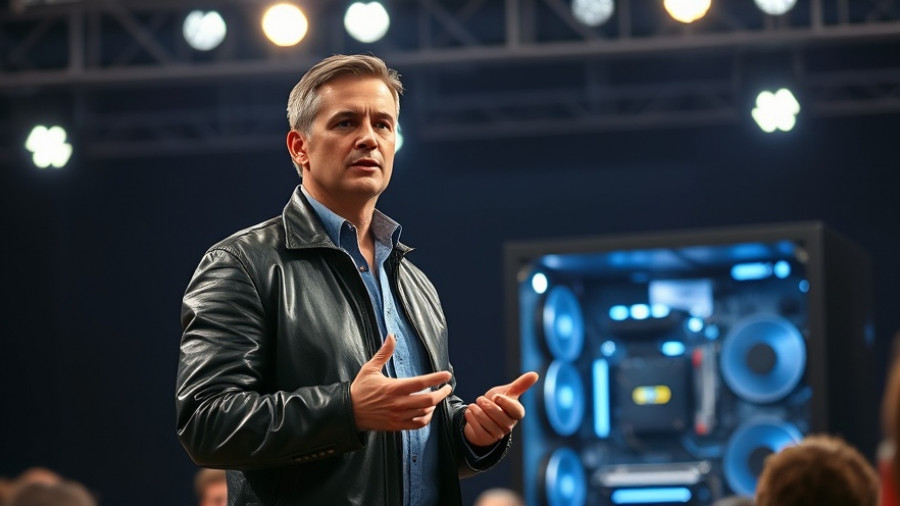
Nvidia and Intel: A Strategic Alliance Reshaping AI Infrastructure
In an unexpected turn that has captured the tech world’s attention, Nvidia Corp. has unlocked a significant $5 billion investment in Intel Corp. This bold partnership, announced on September 18, 2025, aims to co-develop cutting-edge AI-focused custom x86 CPUs that will seamlessly integrate with Nvidia’s renowned RTX GPUs. This collaboration not only marks a critical pivot from competition to cooperation but also signals Nvidia's commitment to enhancing AI capabilities across hyperscale, enterprise, and consumer markets.
This strategic endeavor comes at a vital time for Intel, which has grappled with market share challenges and manufacturing hurdles. By partnering with the dominant player in AI hardware, Nvidia, Intel is poised to regain its competitive edge. Analysts have heralded this alliance as a crucial lifeline for Intel, offering a much-needed influx of capital while accelerating product development timelines that aim to meet the soaring demand for AI processing power.
The Power of Collaboration in AI
The collaboration will see both companies working hand-in-hand to design and roll out multiple generations of integrated products. These will include custom x86 CPUs embedded with Nvidia’s advanced GPU technology utilizing NVLink, a feature poised to revolutionize performance in AI-driven data centers and PCs. With consumers increasingly leaning toward AI-enabled devices, Intel’s development of system-on-chips (SoCs) that leverage Nvidia’s graphics innovations further expands the potential for powerful AI applications in personal computing.
Nvidia’s CEO Jensen Huang emphasized the partnership's potential to “accelerate applications and workloads,” revealing a broader strategy that highlights the critical shift in the computing landscape towards collaborative innovation. For the first time, these two giants are pursuing a shared vision amid their historical rivalry, marrying their strengths to create an extraordinary impact.
The Market Response and Future Outlook
The deal has already incited enthusiasm on Wall Street, with Intel’s shares experiencing a notable surge of over 23% following the announcement. This capital injection not only bolsters Intel's resources but simultaneously reassures investors about the company's future in a rapidly evolving market. According to experts, the partnership aligns well with the ongoing push for advanced manufacturing capabilities in the U.S., particularly in light of recent governmental support for companies like Intel.
Moreover, Nvidia stands to gain considerably from its investment in Intel; the integration of its GPUs into Intel’s products creates a unified architecture that can lock in customers seeking robust AI solutions. As Nvidia embarks on investing up to $100 billion in data centers and other AI initiatives, including a partnership with OpenAI, the landscape of data processing and computing is on the brink of significant transformation.
Challenges and Opportunities Ahead
While the potential benefits of this partnership are substantial, challenges remain. Both companies must navigate numerous risks, including antitrust scrutiny from regulatory bodies seeking to monitor consolidation in the industry. Additionally, there are concerns within the community about whether Intel can deliver on its ambitious timeline, given past delays with product launches.
Nevertheless, the collaborative effort could signal a new era of innovation in AI infrastructure. As Nvidia pivots from being just a chip supplier to a key architect of AI systems, this partnership could reshape how technologies are integrated, developed, and deployed across various sectors.
The AI Ecosystem: What It Means for Enthusiasts
For AI enthusiasts, this strategic partnership presents exciting opportunities, emphasizing the importance of advancements in computational efficiency and performance. The synergy between Nvidia and Intel not only redefines expectations for future products but also enhances existing systems that consumers currently rely on. Understanding these technological advancements is essential for individuals keen on engaging with AI tools and applications in the coming years.
As we continue to witness the interplay between technological giants, the implications of this partnership will ripple across industries, possibly affecting various domains including gaming, professional workflows, and even consumer electronics.
With the AI landscape rapidly changing, staying informed and adaptable is crucial. Nvidia’s move represents not just a financial transaction, but a bold step towards reshaping the very foundations of artificial intelligence and computing as we know it.
In conclusion, as the tech community watches with keen interest, it’s evident that this partnership is just the beginning of a transformative journey that could set new standards in AI performance, price, and consumer access.
 Add Row
Add Row  Add
Add 




Write A Comment